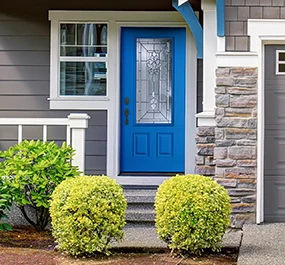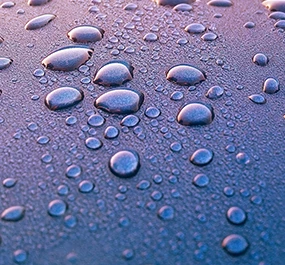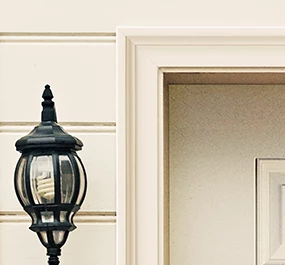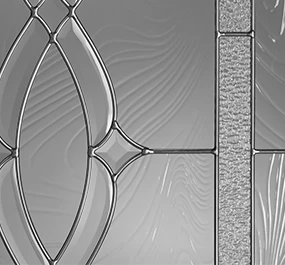If you’re considering an entry door with glass, you might be weighing your options with Low-E glass vs. normal glass. The type of glass you choose can be critical when it comes to factors such as energy efficiency, and depending on where you live, it can be worth it to invest in Low-E glass. Let’s take a look at how Low-E glass is rated and what benefits it can provide vs. normal glass.
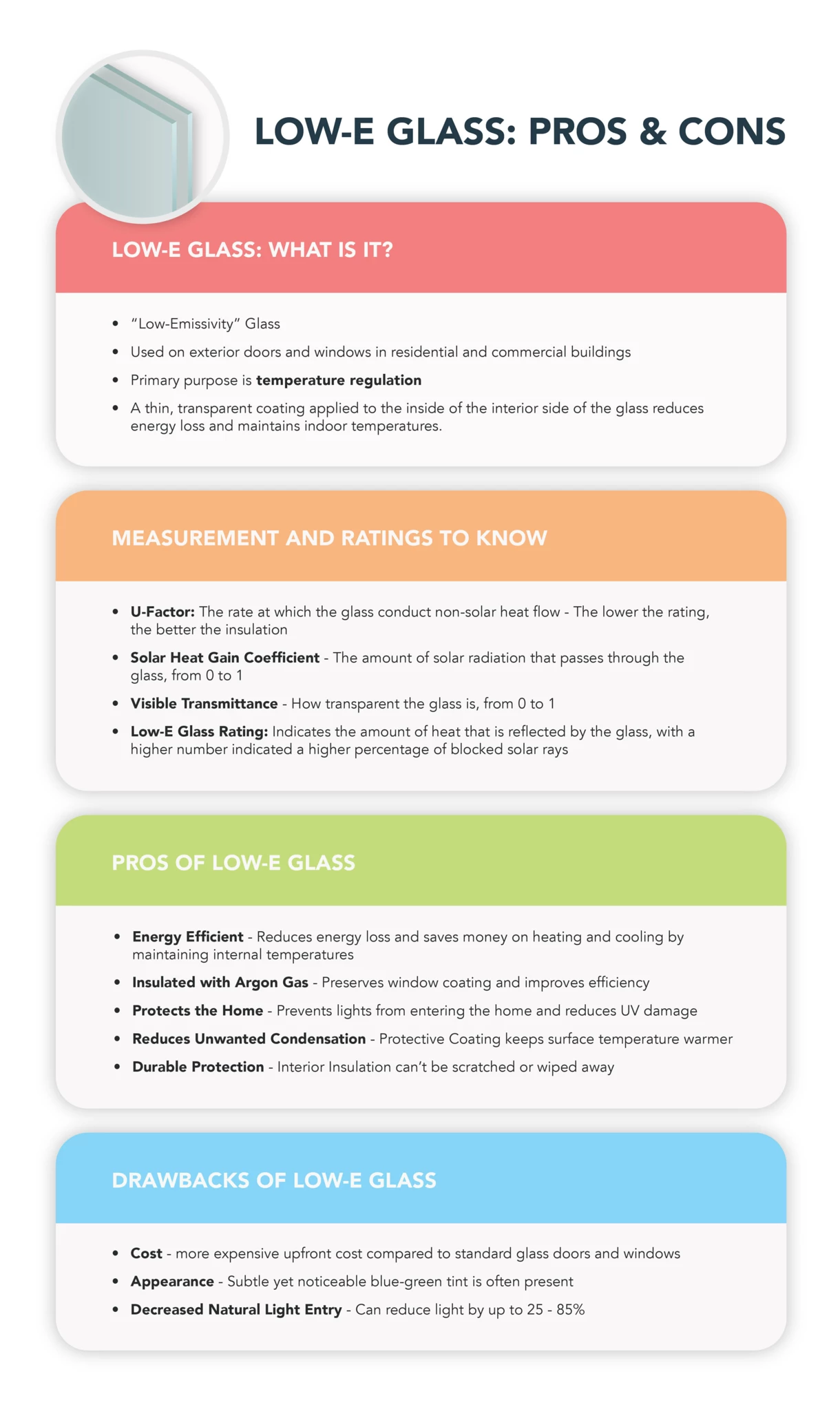
What is Low-E glass?
Low-E stands for “Low-Emissivity”, emissivity meaning the amount of radiation emitted or absorbed. When looking at Low-E glass vs. normal glass, the main difference is that Low-E glass has a thin, transparent coating applied to the inside of the interior side of the glass, reflecting the interior temperatures back inside to reduce energy loss through the glass and maintain indoor temperatures.
Therefore, Low-E glass will keep your home’s temperature cooler or warmer, depending on your climate and season. This coating is so thin that it will not affect the amount of natural light the glass lets indoors—but note that it does have a light, blue-green tint compared to clear glass.
As clear, normal glass does not have this specialized coating, temperature exchange from inside to outside occurs, which can make it difficult to regulate your home’s temperature.
Benefits of Low-E glass vs. normal glass
The special coating of Low-E glass is designed with energy efficiency in mind, but it provides a variety of additional benefits as well.
Energy-efficient
An estimated 70% of energy loss is through windows and doors. Low-E glass will reduce this loss and save homeowners money in the long run on heating and cooling bills by helping to maintain internal temperatures.
Insulated with Argon gas
The majority of Low-E glass utilizes Argon gas between the glass panes. This helps to preserve the window’s coating, but it also improves energy efficiency, as Argon gas has a higher density than plain air, which helps to keep internal temperatures from escaping.
Protects the inside of your home
As Low-E glass prevents certain light from entering your home, it can also prevent damage to your household belongings. UV light can cause damage to the inside of your home over time. By using Low-E glass, you can protect your furniture, walls, carpeting, and even photos from fading and light damage.
Reduce condensation
Condensation that can build up between pieces of front door glass can lead to problems such as foggy glass, mold, or mildew. This happens most notably in winter, when the inside temperature is much higher than the surface temperature of the glass. Low-E glass actually minimizes—and can even eliminate—unwanted condensation, as the protective coating will keep the surface temperature of the glass warmer in the winter.
Durable protection
While there are methods to add insulation to clear glass, Low-E coating is applied to the inside of the glass. Therefore, even though it’s a thin, transparent coating, it can’t be scratched or wiped away.
Low-E Glass Measurement and Ratings
Not all Low-E glass is the same, and it can come in many forms, with different types of ratings and coatings for high, moderate, or low solar heat gain in cold, temperate, or hot climates. Different glass and coatings will provide a different level of performance, and it’s important to understand your options. A few things you should keep in mind:
U-Factor
The U-Factor is the rate at which the glass conducts non-solar heat flow—or, how well the product keeps heat trapped inside. These ratings will typically fall between .25 and 1.25. Generally, the lower the rating is, the better the insulation.
Solar Heat Gain Coefficient
The Solar Heat Gain Coefficient (SHGC) is the amount of solar radiation that passes through a product. This rating will typically be measured between 0 and 1. The desirable coefficient depends on where you live- in warmer climates a lower solar heat gain coefficient will help keep the indoors cool, but in cooler climates a higher solar heat gain coefficient can help to keep the home warm.
Visible transmittance
Visible transmittance is how transparent the glass is. This is typically measured between 0 and 1. To allow as much natural light as possible to come through, you might look for glass with a rating closer to 1.
Low E Glass Rating
Low-E glass comes in a series of ratings depending on the amount of heat that is reflected back. Depending on the manufacturer, ratings will appear differently, but a higher number indicates a higher percentage of solar rays that are blocked. This will subsequently affect the U-Factor and SHGC, meaning that different ratings will provide various levels of energy performance.
The most commonly seen ratings are Low E 2 and Low E 3. Which rating to go with will depend on a variety of factors, including your location and budget. Generally, Low E 3 is considered a strong all-around rating, as it provides enhanced performance in hot and cold weather.
Low-E glass vs. normal glass
With all of this in mind, it’s clear that Low-E glass provides additional benefits compared to normal, clear glass. But is it right for you? When making your decision, you will want to determine the most important factors for your situation, including:
Cost
The benefits of Low-E glass will come with increased cost. Consider which option fits best into your budget. However, it should be noted that long-term cost—as it relates to future heating and cooling bills—should also be factored in, as Low-E glass will provide savings over time.
Energy efficiency
If your main concern is energy efficiency, then Low-E glass is a clear winner. As covered, the specialized design will keep your home more comfortable and keep your energy bills lower.
Appearance
While Low-E glass doesn’t block natural light, it does have a noticeable tint compared to clear glass. Some homeowners may opt for clear glass to avoid the blue-green hue.
Plastpro’s selection of Low-E door glass
Plastpro’s offers a selection of doors with Low-E glass—check out our Doorlite collection to see our wide range of glass options. If you are looking to maximize both natural light and efficiency, our Nova Door Series features Low-E glass options, including LoE 366. These doors are made with direct glazed glass, which creates a seamless blend between the glass and the door. The beauty and boosted natural light from the Nova Series, coupled with the energy efficiency benefits of the Low-E coating, make this an excellent front door option wherever you are.
To explore Plastpro’s selection of fiberglass doors and Low-E glass options, check out our Where to Buy page to find a dealer near you.
